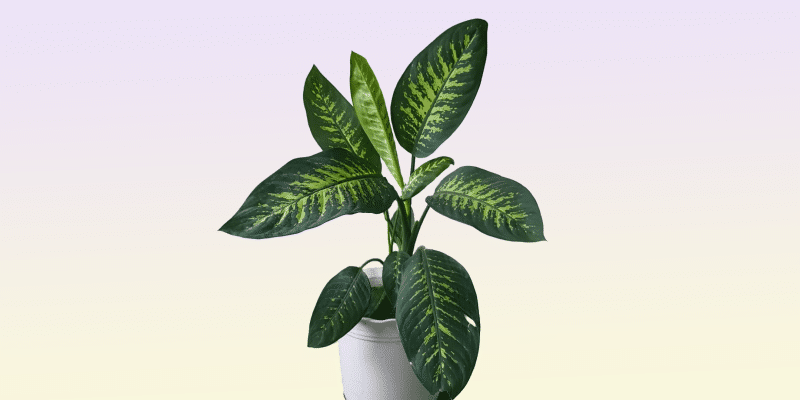Dieffenbachia are popular houseplants for a reason, but also require some care due to their ‘dumb cane’ heritage.
Easy to care for, with broad, variegated leaves, but a tricky sap. Sounds about right.
Dumb cane plants have been popularly kept indoors since Victorian times, and for good reason. We’ll cover the history of these plants, how to care for them, and what to do if you see some of the most common issues that come up.
We also have a propagation guide that covers our favorite way to make more of these as gifts for your friends.
(Or just to hoard for yourself.)
Table of Contents
Dieffenbachia Care Guide
History, habitat, and characteristics
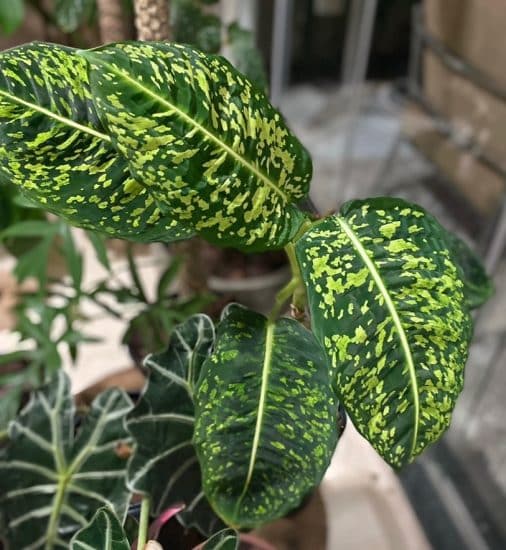
The Dieffenbachia genus (Dumb Cane) contains some excellent houseplants for beginners and really anyone attracted to their beauty. Almost all Dieffenbachia you come across will be Diffenbachia seguine, native to Central and South America, with roots running back hundreds of years as a cultivated indoor plant.
Thanks to its low-maintenance upkeep needs and stunning foliage, it’s no surprise that this beloved houseplant has held its place in history.
Heinrich Wilhem Schott coined the genus name Dieffenbachia in 1829, in memory of his late friend Joann Dieffenbach, and it was the Victorian era that truly popularized this species, thanks to its striking foliage.
Along with a vast array of interesting markings and colors, D. seguine also carries a unique history from whence its common name Dumb Cane originates.
Do note that this plant contains irritants that, if ingested, can cause temporary difficulty speaking and swallowing. Be careful with this plant around any small children, pets, and when handling it yourself.
Dumb cane is adorned with showy, pointed leaves that range widely in color and variegation. Bright green, yellow, and creamy whites paint this extraordinary pot of life, which can grow up to 8 feet in tropical climates.
Where its charm and beauty stop, its air filtering capabilities pick up. Dieffenbachia plants were studied by NASA in their landmark study and were proven to filter formaldehyde, xylene, and toluene (all commonly found in homes often due to couches and furniture that off-gas).
When mature, Dieffenbachia often produces a single light violet-colored spadix, contained within a spathe, on top of its strong, sturdy stem.
Dieffenbachia variants and species
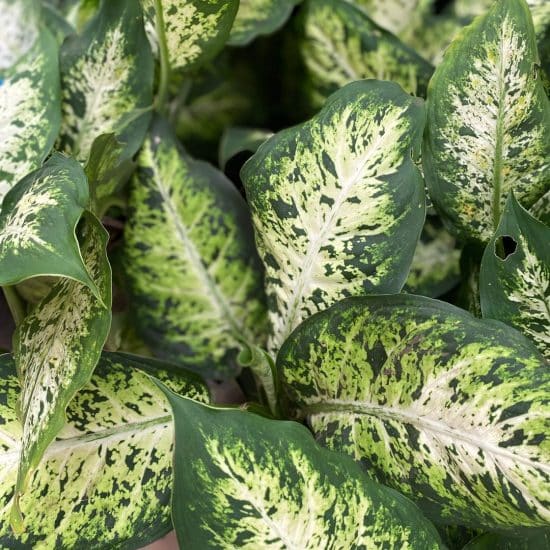
The Dieffenbachia plant genus contains over 100 species, though most of them aren’t commonly grown as houseplants. We’ll be focusing on one species in particular and the many varieties available.
Dieffenbachia seguine. The most common species, known as the dumb cane plant. If you’re at a garden center and see a plant just named Dieffenbachia or dumb cane, this is the plant they’re referring to. This was previously known as Dieffenbachia maculata and Dieffenbachia picta. New name, same lovable plant.
For the rest of these varieties, plant care will be basically the same as we describe in this guide. The main difference is going to be around size, leaf variegation, and speed of growth.
Let’s cover both.
Size and growing speed: as dieffenbachia grow, they need more nutrients and water, and have higher light requirements. If you purchase a plant that is known for growing faster or being a bit larger, you’ll just want to be mindful that it’s given enough indirect sunlight.
Variegation: the less green you see on a leaf, the more indirect sunlight it will need (due to less chlorophyll). If you notice the leaves turning all green or slowing down, you can encourage growth by moving your plant closer to a window or adding some artificial lighting.
Variants
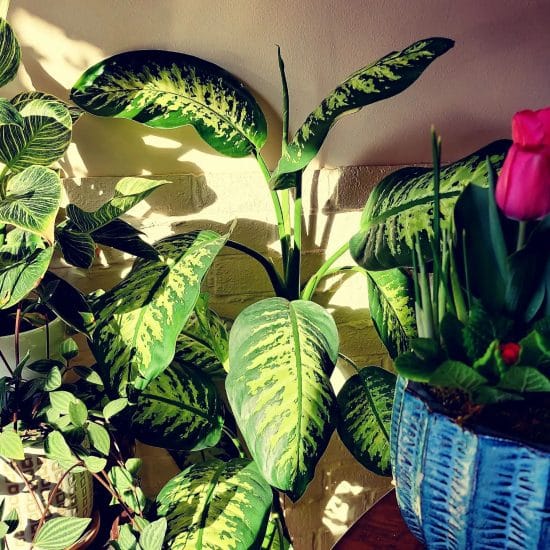
On to our favorite Dieffenbachia houseplant varieties.
(Keep in mind that dumb cane is a very popular plant, so we’re always seeing new variants emerge, and we’ll add them here as we find them!)
Dieffenbachia “Reflector” – This dumb cane plant is so aptly named, with bright (almost blinding in the nursery where we got ours) yellow-ish green leaves. They’re broad with hints of rich deep greens.
Dieffenbachia “Camilla” – Couldn’t look more different than the previous variety. D. Camilla features intensely white leaves, in some cases making up almost 90% of the volume. In our experience, these need a lot of light so they retain some of this white, and they can be a lot more difficult to care for, with easily burnt edges. An absolutely stunning plant.
Dieffenbachia “Camouflage” – Easier to care for, with wavy, long leaves bordering on chartreuse, with gentle flecks of dark green. Heavily patterned leaves.
Dieffenbachia “Tropic Snow” – Variegated species that span from yellow leaves to deep greens, and all the creamy hues between. These can grow quite tall for a variegated plant, so consider keeping them on the floor. One of the most popular cultivars, leaves can be a bit smaller than other varieties.
Dieffenbachia “Amoena” – Thought for a while to be a distinct species, this is actually now considered to be a seguine variety. Variegation and a strong central midrib spanning yellows to dark green.
Dieffenbachia “Green Magic” – We know houseplants sometimes get exotic names, but this variety really is magical in how different it looks from other Dieffenbachia varieties. It features completely dark green leaves, with almost a velvety texture that can glint under bright lights due to the calcium oxalate crystals. Contrast those leaves with its central midrib: such a look!
No matter what you choose, be sure to remain cautious when handling this houseplant. Those same crystals are extremely present throughout the plant, especially in its central stem.
Light
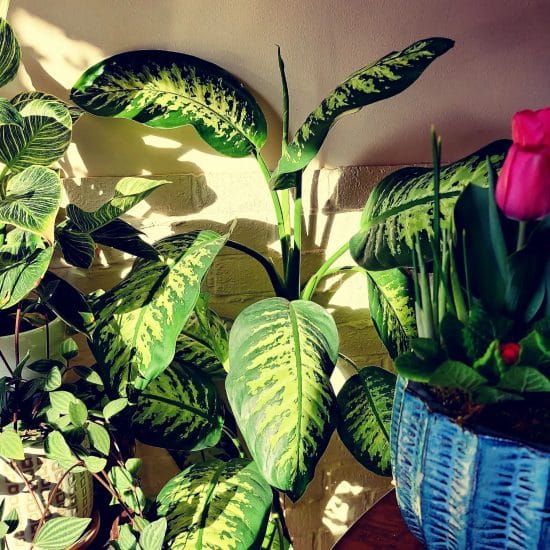
Our Dieffenbachia care begins with light: I wouldn’t quite call it walking a tightrope, but balance is key for taking care of these plants. They tend to love bright, indirect light, and their leaves will tell you pretty directly whether they’re happy or not.
They’re pretty adaptable. In medium lighting conditions or in a dim room, you’ll notice your Dieffenbachia leaves turning toward your windows and sources of light, so you’ll want to rotate them if you can to create a well-rounded plant. No shame if you just want to park it in a corner, but you’ll have a plant with a very prominent front and back.
They also do well in lower light, but you’ll see smaller leaves with significantly less variegation.
Lighting tips:
- If you notice small leaves which aren’t growing at all, and little growth from the top of the plant, it likely needs significantly more bright light.
- Low light and partial shade are tolerated but will encourage spindly stems as your dumb cane reaches for enough light.
- Avoid exposure to direct sun for extended periods, as it can cause the leaves to crisp or burn.
Pay attention to the direction of the window your Dumb Cane plant is closest to. North and east-facing windows have bright indirect light and allow for closer placement. If your plant is near a south or west-facing window, you’ll need to make sure they’re at least a few feet away from that direct sunlight unless your building is in shade or you have a curtain.
Water
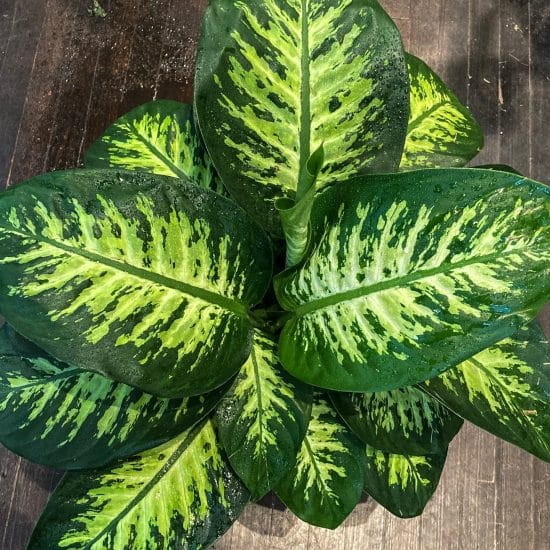
Dieffenbachia wears its heart on its sleeve when it comes to water, which actually makes it a lot easier to care for than other indoor plants which might be a bit more drought-tolerant.
What does that mean?
This makes it really easy to know the cause of a problem with your plant. If your dumb cane plant is thirsty, you’ll see drooping leaves pretty quickly. If the soil is dry and it perks back up after giving it a good, deep drink, you can be pretty confident you’ve figured out the issue.
Dumb cane don’t really mind slightly moist soil (we’ll cover the right mix a bit later), so more frequent watering isn’t the worst, as long as your pot has drainage holes and isn’t standing in sitting water.
Generally, you’ll want to calibrate your water to your growth, so needs increase during the spring and summer, and with faster-growing plants in more light. If it’s winter and a bit darker, you can probably reduce the watering frequency a fair bit.
Always check the soil with a finger before watering. It should never be wet. If it’s pretty damp, you can still wait a few days before adding more water.
A note on the water you use — ideally filtered or rainwater, but these plants are pretty forgiving with tap water. If you do use tap water, make sure it’s not too cold, and let it sit out for a few hours first to let some impurities off-gas (or boil it and wait until it hits room temp again).
Overwatering is a common cause of houseplant issues, so it is important to be aware of the signs of an overwatered Dumb Cane. Overwatering will present itself with wilted, yellow, or brown leaves. Additionally, check the roots; if they are slimy, moldy, or discolored and dark, your houseplant is likely overwatered.
On the other hand, underwatering also causes damage; your dumb cane’s leaves may show signs of curling or crispy edges and will look generally wilted and dry.
Temperature and humidity
Dieffenbachias have a really wide range of temperatures they’re comfortable in, but don’t like much below 60 degrees. 65-75 F is really the sweet spot of comfort for this tropical plant.
If you notice your dumb cane plant getting a bit droopy and you haven’t been slacking on the water, check the temperature or for drafts. Drafty windows or spots close to air conditioners can get a lot cooler than the rest of your room, so try to find a warmer spot.
Humidity can be more of a concern if you’re really looking for fast growth, but typically the levels that are comfortable for you will keep this plant in good shape too. Aim for around 50% high humidity. This isn’t always easy, and a lot of people aren’t even sure what the moisture level is in their home before owning plants, so we have a few tricks to keep high humidity up without making you too uncomfortable.
The trick is to raise the local humidity for your plants so that it’s more humid around them but not in the rest of your house. Think of it like a little tropical vacation for your plant… all from the comfort of your home. You can do this in a few ways:
- Use a pebble tray. You fill a shallow tray up with pebbles and a bit of water, and as the water evaporates your plants, will thank you.
- Group your plants together, as this increases the local levels through transpiration.
- Do not mist your plant without wiping it off after, since this can result in pests and rot.
Soil and planting
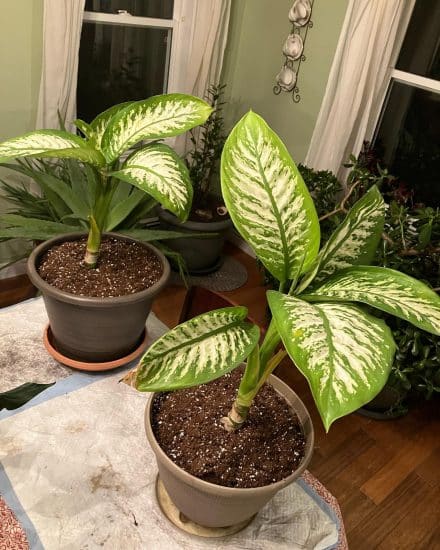
Dieffenbachia thrives in well-draining soil that retains moisture and is full of air. An ideal potting soil mix for this plant contains:
- 60% coco coir/peat moss
- 20% compost
- 20% perlite
The roots of Dieffenbachia do need some help with water uptake, so having a damper soil is beneficial. We add the perlite or coarse sand so that there’s still plenty of water and air movement through the soil. These plants love oxygen (not so much root rot).
They prefer to dry out a bit after being watered, so make sure to read the water section above.
Signs of poor soil: leaves will turn yellow, or you’ll notice significantly droopy leaves. You can pull these off when they’re ready to come off. You don’t want to cut prematurely, as this can leave the plant vulnerable to issues (and also release its sap, which is toxic).
Fertilizing
Dumb Cane plant really benefits from fertilizing, especially when younger. Their immature root systems aren’t great at uptaking nutrients, so use a complete liquid fertilizer that’s very (more than 50%) diluted. Fertilize lightly every few weeks when you see growth.
So, does that mean continuing in the winter? Absolutely! If you’re seeing growth, it means you have an active plant, which could be due to a warm home, a lot of artificial lights, etc.
Instead of fertilizing, you can also topdress with worm castings.
Signs of too much fertilizer: you’ll notice curling leaves, with damaged outer edges. You’ll want to leach these nutrients back out of the soil with plenty of water and reduce your fertilizing frequency significantly.
Most plants do go dormant in the winter, so this is really just advice for a Dieffenbachia plant.
Propagation guide
Our recommended way to propagate a Dieffenbachia plant is through stem cuttings in water.
You’ll want to take some recent growth from the top, and make sure you’re taking a few leaves from the cutting. You’ll want to wear gloves while doing this because the plant’s sap is a very strong irritant.
To propagate dumb cane from a stem cutting:
You’ll need gloves, cutting shears (that you’ll sanitize before and after), and an active, healthy, and growing plant.
- Take a cutting at least 4″ long, with at least a few healthy leaves.
- Pull off any leaves lower on the stem — these are nodes and where roots will form once placed in water.
- Trim the stem so that these nodes are close to the bottom.
- Place the cutting in water and give plenty of light for the next 2-4 weeks.
Once you see new roots appear at least a few inches long, you can transplant them into potting soil (a similar mix as the one described in the earlier section). Make sure to keep the soil moist for a month or so, and as high humidity as you can muster.
Common issues
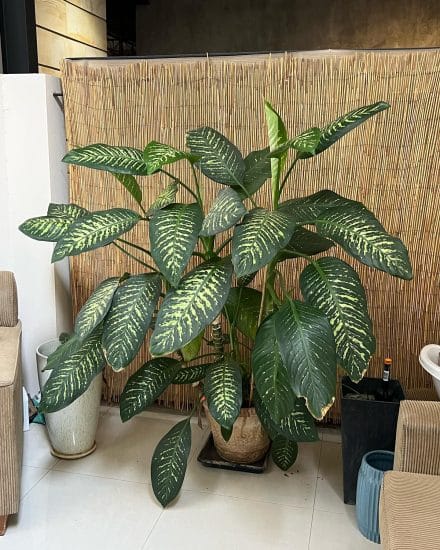
Dieffenbachia plants are some of the most popular indoor plants, and they do suffer from some of the same issues as others.
The issues here are categorized as visual issues that can have different causes. Our goal is to help you figure out how to troubleshoot your particular plant while also avoiding some of these issues along the way.
Yellowing leaves
This can be a bit tricky to diagnose, so let’s put on our deerstalkers (any Sherlock fans?) and get to some detective work.
First, you’ll want to examine where the yellow leaves are on your plant, and where on the leaf the yellowing is occurring. If you notice brown leaf edges that seem crispy, this is likely an issue with underwatering your dumb cane plant.
You’ll want to check both that the soil is retaining enough water and that it isn’t allowed to dry out for too long.
If your dieffenbachia plant’s leaves look fine on the top and it’s just the lower leaves, this might not even be a problem. Mature leaves do fall off from time to time, especially in the winter. Just make sure you haven’t given it any temperature shocks.
If the soil does feel moist and you haven’t been using too much fertilizer, this could be root rot, which we’ll cover in the next section. Dumb canes don’t tolerate sitting in water, so this is an opportunity to check that there’s enough drainage, and that if you’re using a decorative pot, there isn’t water pooling inside.
Brown tips on leaves
Brown tips on dumb canes are almost always an issue from salt or nutrient build-up, especially with frequent use of fertilizer.
Solution: You’ll want to flush the soil with water to leach out any remaining salts and excessive nitrogen.
Diseases and pests
Despite the risks from sap exposure, pests are still a problem for dumb cane. This does make taking care of a damaged plant a little bit more tricky, so we recommend you always wear gloves when handling.
We’ve also noticed that often the stems will become much harder and brown, almost like bamboo, as the plant attempts to protect itself.
Mealybugs
For some reason, these seem to be a particularly bad issue for Dieffenbachia. Even if your plant seems healthy, you might notice some of these. They’ll look like small white bugs or puffs of cotton underneath the leaves.
Solution: Isolate your plant from the others and clean the leaves with soapy water or neem oil. You can also remove the mealybugs themselves with alcohol and a cotton ball.
Spider Mites
Spider mites love to feed on the sap and juice from leaves, so you’ll notice holes, brown spots, or maybe even the webbing itself. The mites can be pretty tiny, so they can be hard to spot.
Solution: Same as above; you’ll want to isolate and treat the leaves immediately.
Root Rot
Root rot is a common problem with dumb cane caused by overwatering. Check the roots by removing the plant from its soil and examining them. If the roots are brown, soft, and slimy, root rot may be present. Cut off the affected roots and repot in fresh, aerated soil. Make sure the soil is allowed to dry between waterings.
Without drainage holes, excess water won’t be able to escape the soil, and the plant can become prone to over-watering and root rot, leading to yellowed or browned edges on the leaves, curling, and drooping.
When you check the soil, make sure you see not just previously established mature roots, but also tinier, younger roots. If you do, this is a great sign and likely means you have a good potting soil mix with good watering frequency.
Powdery Mildew
Powdery mildew is a type of fungal infection caused by the podosphaera xanthii fungus. You’ll notice white powdery spots on your leaves which can grow until they cover the entire plant, starving it of light.
Solution: First separate your plant from any others indoors. You’ll then want to remove any affected leaves (pulling off is better than cutting if they come off easily). Treat your leaves/soil with a fungicide (you can find one at any gardening center) and keep your plant in slightly higher air circulation than before. You’ll also want to make sure your leaves/stems aren’t sitting wet after watering.
Remember, the best way to avoid these issues is to keep the plant in its ideal condition.
You’ll want to plant it in well-aerated soil, making sure the pot isn’t too large. Your plant should be kept away from direct light and anywhere that can get a chill. Lastly, it’s best off in an area with relatively consistent temperatures.
Conclusion
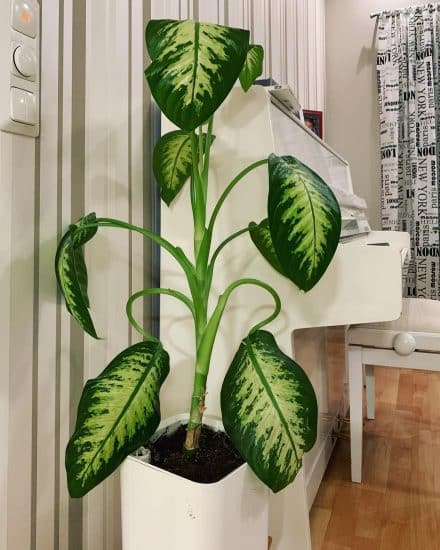
Dieffenbachia (dumb cane plant) is a fantastic plant to keep indoors and a great new plant to purchase for a beginner. They’re widely available at most garden centers, but you do need to take care in handling them because of their highly irritating sap.
Our care tips:
- Give these plants plenty of indirect bright light, but avoid direct sunlight for too long or you’ll notice leaves turning brown and crispy.
- Fertilize not just during the growing season, but whenever you see new growth, which might be in the winter.
- Keep the temperature above 65 degrees, avoiding cold drafts and inconsistent temperatures.
- Lower leaves can yellow and fall off in all Dieffenbachia plant species, so don’t be alarmed. New leaves should continue to grow from the top, which you can cut off to propagate new plants.
Dieffenbachia are really some of the easiest houseplants to care for, but if you do have issues, feel free to reach out to us, and we’ll help you diagnose what is likely a common problem seen by many.
Take care!
FAQ
Does dumb cane purify the air?
They do! Dieffenbachia plants were studied by NASA in their landmark study and proven to filter formaldehyde xylene and toluene, commonly found in homes (often due to couches and other furniture that off-gas).
How often do you water a dumb cane?
When growing indoors, dieffenbachia typically prefer to have their soil remain moist. We can accomplish that not by frequent watering but using soil that retains a bit more moisture than most tropical plants prefer. That means lots of peat moss/coco coir. Once it’s dry, it’s time to water.
Is Dieffenbachia toxic to dogs?
Absolutely, it is not safe for small children or pets, and you should be careful handling it yourself, especially if you prune Dieffenbachia. Many plants contain calcium oxalate crystals, this one in abundance.
Is Dieffenbachia hard to care for?
Growing dieffenbachia is a breeze! They are tricky plants, but that’s mostly because of their sap and handling them, not keeping them alive. Just keep them out of direct sunlight and don’t let them dry out for too long. Even if you do mess up a bit, almost all dieffenbachia houseplants can be revived, and you’ll see new growth as soon as you calibrate those conditions just right. For this plant, care is easy!

